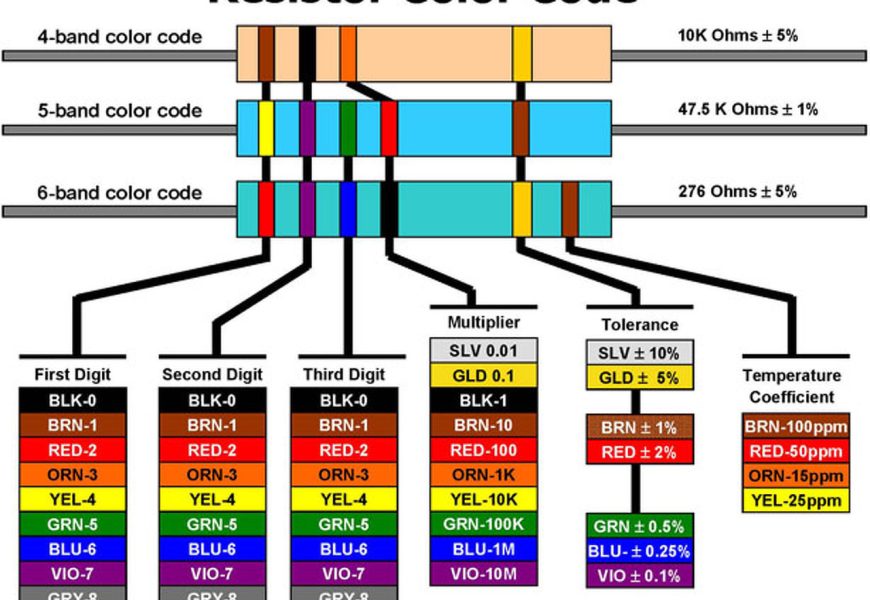Resistors are essential components in electronics, playing a critical role in controlling current flow. To identify resistor values accurately, manufacturers use a color-coding system that’s simple to learn and apply. This article will guide you through the resistor color code, explaining what each color represents and how to calculate the resistance value using this color code system.
What is a Resistor Color Code?
Resistor color codes are standardized color bands printed on the body of a resistor. Each color represents a number and helps identify the resistance value, tolerance, and sometimes temperature coefficient of the resistor. This system makes it easier to determine the resistor value without needing to measure it with a multimeter.
Why is the Resistor Color Code Important?
The color code system is essential because:
- Convenient Identification: It allows for easy and quick identification of a resistor’s value.
- Space Efficiency: It eliminates the need for large printed labels, which would be impractical on small components.
- Standardization: The color code is standardized by international organizations, making it universally understood.
Understanding the Resistor Color Code Chart
The resistor color code chart consists of ten colors, each corresponding to a number from 0 to 9. Here’s the standard color code:
| Color | Digit | Multiplier | Tolerance |
|---|---|---|---|
| Black | 0 | 10010^0 = 1 | N/A |
| Brown | 1 | 10110^1 = 10 | ±1% |
| Red | 2 | 10210^2 = 100 | ±2% |
| Orange | 3 | 10310^3 = 1,000 | N/A |
| Yellow | 4 | 10410^4 = 10,000 | N/A |
| Green | 5 | 10510^5 = 100,000 | ±0.5% |
| Blue | 6 | 10610^6 = 1,000,000 | ±0.25% |
| Violet | 7 | 10710^7 = 10,000,000 | ±0.1% |
| Gray | 8 | 10810^8 = 100,000,000 | ±0.05% |
| White | 9 | 10910^9 = 1,000,000,000 | N/A |
| Gold | N/A | 10−110^{-1} = 0.1 | ±5% |
| Silver | N/A | 10−210^{-2} = 0.01 | ±10% |
How to Read the Resistor Color Code
Resistors commonly use a 4-band or 5-band color code system. Let’s look at how to read each one.
1. 4-Band Resistor Color Code
The 4-band resistor color code is widely used for general-purpose resistors. Here’s how to interpret it:
- Band 1: First significant digit
- Band 2: Second significant digit
- Band 3: Multiplier (or power of 10)
- Band 4: Tolerance
For example, if the bands are Red, Violet, Yellow, and Gold:
- Red (2), Violet (7), Yellow (10,000), and Gold (±5%)
- The resistance value would be 27 x 10,000 = 270,000 ohms or 270 kΩ with a tolerance of ±5%.
2. 5-Band Resistor Color Code
The 5-band resistor color code is commonly used in precision resistors, where values are more accurate.
- Band 1: First significant digit
- Band 2: Second significant digit
- Band 3: Third significant digit
- Band 4: Multiplier
- Band 5: Tolerance
For example, if the bands are Green, Blue, Black, Brown, and Brown:
- Green (5), Blue (6), Black (0), Brown (10), and Brown (±1%)
- The resistance value would be 560 x 10 = 5,600 ohms or 5.6 kΩ with a tolerance of ±1%.
Common Types of Tolerance in Resistors
The tolerance of a resistor indicates how much the actual resistance can vary from the stated value:
- ±5% Tolerance: Often represented by a gold band, this tolerance is typical for general-purpose resistors.
- ±1% or Lower Tolerance: Indicated by colors like brown, green, or blue, this tolerance is common in precision resistors.
Calculating Resistance Using the Color Code
- Identify the Color Bands: Start with Band 1 and move towards the tolerance band.
- Apply the Color Code Chart: Convert each color into its corresponding digit and multiplier.
- Calculate the Value: Multiply the significant digits by the multiplier, then factor in the tolerance.
For example:
- Colors: Red, Red, Black, Brown, Brown
- Calculation: 220 x 10 = 2200 ohms or 2.2 kΩ ±1%
Other Variants in Resistor Color Coding
Aside from the standard 4-band and 5-band codes, some resistors use a 6-band color code. The sixth band usually indicates the temperature coefficient of the resistor, measured in parts per million per degree Celsius (ppm/°C). This is especially useful in applications requiring high stability across varying temperatures.
6-Band Resistor Color Code
In a 6-band color code:
- Bands 1, 2, and 3: Represent the significant digits.
- Band 4: Multiplier.
- Band 5: Tolerance.
- Band 6: Temperature coefficient.
For example, in a 6-band resistor with colors Brown, Black, Black, Orange, Brown, and Blue:
- Brown (1), Black (0), Black (0), Orange (1,000 multiplier), Brown (±1% tolerance), Blue (10 ppm/°C).
- The resistance value would be 100 x 1,000 = 100,000 ohms or 100 kΩ with ±1% tolerance and a temperature coefficient of 10 ppm/°C.
Practical Applications of Resistor Color Code Knowledge
Knowing how to read resistor color codes is essential in practical electronics for:
- Circuit Assembly: Quickly identifying resistors helps when assembling circuits without repeatedly checking each resistor value with a multimeter.
- Troubleshooting and Repair: Color coding assists in verifying correct resistor placements or finding faulty resistors when repairing circuits.
- Component Organization: Properly categorizing resistors by their color codes simplifies inventory management and project preparation.
Advanced Color Coding for High Precision Resistors
For high-precision resistors, the tolerance band often uses special colors like pink or turquoise to represent even tighter tolerances, such as ±0.01%. These resistors are typically used in sensitive measurement equipment and calibration devices.
Challenges in Reading Resistor Color Codes
While color codes are widely used, there are a few challenges:
- Reading Small Resistors: Tiny resistors may have colors that are difficult to distinguish due to limited space and fading over time.
- Color Blindness: For those with color vision deficiencies, distinguishing between similar colors like red and brown or green and blue can be challenging.
- Environmental Impact: Over time, exposure to heat or sunlight can cause color bands to fade, making identification more difficult.
Solutions:
- Using Multimeters: When in doubt, a digital multimeter can measure resistance accurately.
- Organizational Tools: Sorting resistors by value and storing them in labeled compartments can reduce reliance on visual color identification.
- High-Contrast Resistor Tools: Some tools, such as mobile apps, offer high-contrast settings that help color-blind users identify resistor values.
Conclusion
Understanding the resistor color code is fundamental in electronics, allowing for quick identification and use of resistors without needing a multimeter. With this guide, you can confidently calculate resistor values, interpret tolerances, and improve your skills in working with resistors. Whether for hobbyist projects or professional work, mastering the resistor color code is a valuable tool for any electronics enthusiast.











